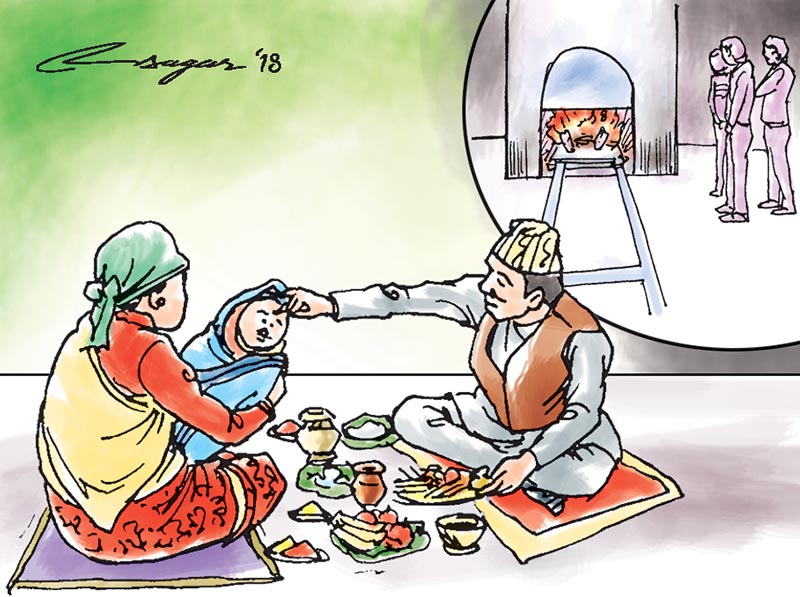Living and dying: Some issues to ponder
The issues of living and dying are personal matters and in this modern age cannot be dictated by clergy or pundits who, having vested interests are sadly out of date. The answer may be that the Hindu religion has to be reformed
The dwellers of this Indian subcontinent are mainly Buddhists, Hindus, Muslims and Parsees. The Jewish faith was perhaps introduced in India centuries ago and some adherents in NE India have been accepted as the “lost tribe” and allowed immigration to Israel. Christianity was introduced in India by both St Thomas and by priests from the Vatican who travelled through Nepal to go to China to convert the people there to Christianity. In a cauldron of religious strife in India, the Sikh religion was started by Guru Nanak and the subsequent nine Gurus by combining various practices from Hinduism and Islam.
The situation now is that faiths which do not allow conversion are gradually decreasing in numbers to those that do. Difficulty in observing existing absurd customs, which are costly too in this modern age, may be the motivation to convert? In olden days it was customary to consult patros or almanacs for the most opportune moment to set out on journeys.
Surprisingly, not only deaths but even births are taken by some as unwelcome occurrences prior to pujas or weddings. Those involved in the events go around proclaiming, “Don’t tell us” or “We haven’t heard anything”. Isn’t this the height of sheer hypocrisy?
Perhaps the caste system is a drawback of Hinduism and the fact is that, though not rigid in ancient times, it is so now. Of course, our Hindu religion has had reformers such as Vivekananda, the Ananda Margis and the Sanatan Dharma advocates but their influence and reach have been very limited. Categorisation of people as low castes, untouchables or Dalits cannot be condoned.
Reality is that some of our mores and customs are archaic. Funnily some diehards of the caste hierarchy still maintain the categorisation of food stuff as chokho or bitulo. Were Bahuns not eating bitulo chauws or mushrooms simply because they knew these as being
poisonous!
Some vegetables which grow under the soil surface are labelled bitulo but this rule has exceptions.
Similarly, all vegetables growing above the ground are not chokho. Such irrationality, without any rhyme or reason, has been handed down the ages.
The Hinduism practised in Nepal is outdated and is not in conformity with the times that we are living in. It was drummed into us that the Gyatari Mantra was something which only boys, who had had the ceremonial bratabanda performed had to recite it out of others hearing. Who was our patriarch advocating all this? Was it the Mahila Pandit of Rana days? Was it the monarch of the land aka Vishnu Avatar? Was it him or his Guru – the Rajpurohit?
In Nepal, only those born as Hindus may enter the precincts of the temples such as at Pashupati. More ardent, enthusiastic and perhaps very sincere followers, eg ISKON adherents or beefeater Hindus from Bali are forbidden. Surprisingly Buddhist practices are much more practicable as for all the deities in the temples are accepted by both Buddhists and Hindus.
Fortunately, in Nepal the attitude of the so-called high classes is not that rigid in that priest at some of our temples are from the “backward” or shunned communities – eg Dalits. Offerings made to Devi Goddesses are eagerly devoured by the worshipping higher classes.
Bringing about change takes a long time as is proved by the fact that untouchability was banned in the 1960s, during King Mahendra’ time. Practices such as Haliaya, Chhaupadi and child marriage have been disallowed periodically by law but their setbacks still persist.
Reform is a dire requirement of Hinduism. A case in point is the 13 days of formal mourning observance that is mandatory for current followers of the Hindu faith in Nepal.
It means inactivity, seclusion, unnecessary expenditure and observance of rituals which any rational being would say is no longer necessary.
Prime Minister Juddha Shumsher in the 1940s had decreed the wearing of white clothes for a whole year as unnecessary and permitted grieving individuals to wear his usual clothes with a white cap on his head and canvas shoes on his feet.
A major change which has occurred is the giving of the Daag Batti and performing the kiriya by the daughter/s in cases where no sons were available in the family. Some other attempts have taken place to bring about change in the accustomed thinking and the prevailing practices.
Some Brahmin families, albeit outside of Nepal, observed only five days of mourning. It is time that the educated elites of the different family clusters (gotras) get together, perhaps at Devali times and come to a consensus as to what to do in their particular samaaz. The use of the crematorium instead of the traditional funeral pyres has been introduced in the Capital and should be extended. This will lessen firewood demand and thereby prevent the cutting down of trees.
The issues of living and dying are personal matters and in this modern age cannot be dictated by clergy or pundits who, having vested interests are sadly out of date. The answer may be that the Hindu religion has to be reformed and this process can only be carried out and attained as a result of awareness and demand by the practitioners. The traditional practices should be modified or changed to be in conformity to the requirements of a modern world.






